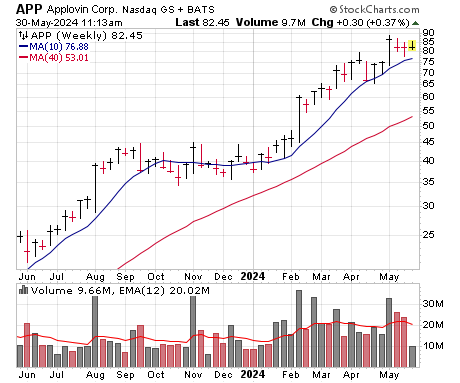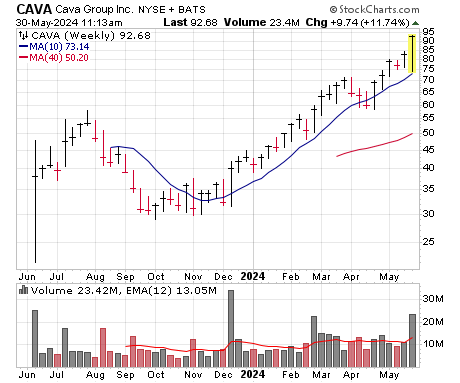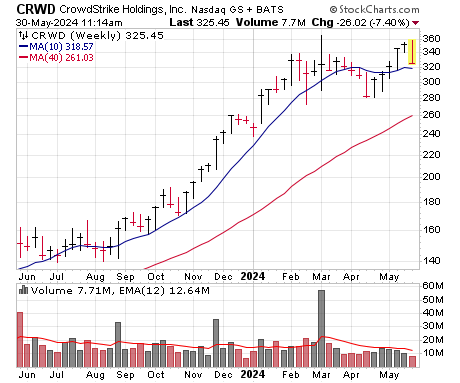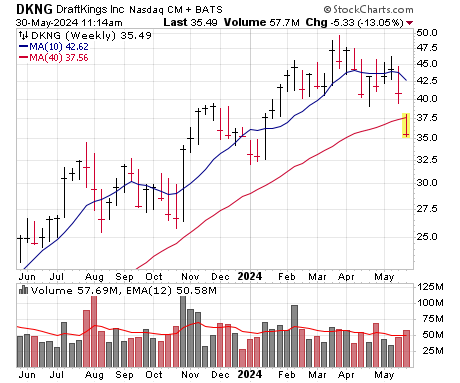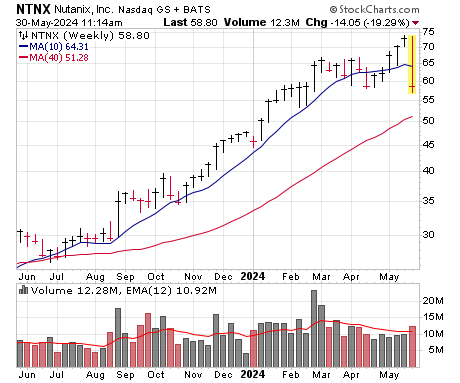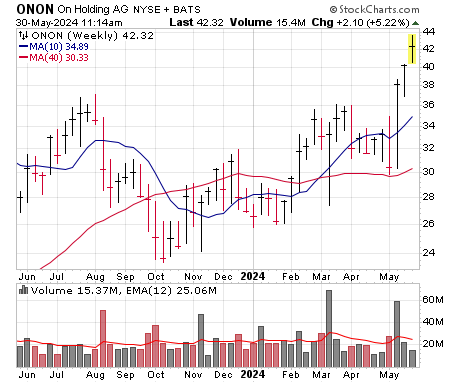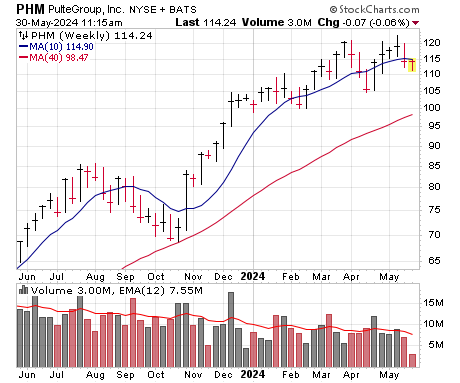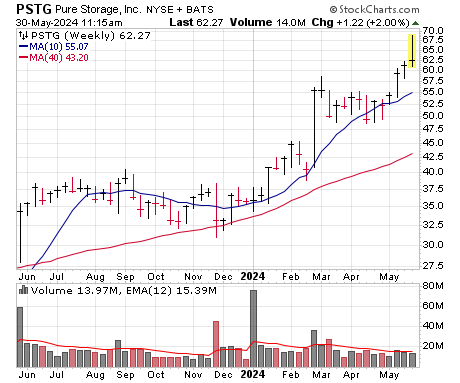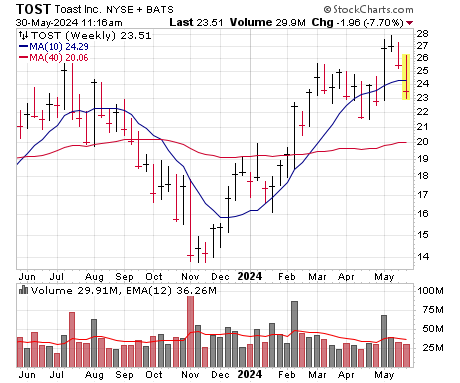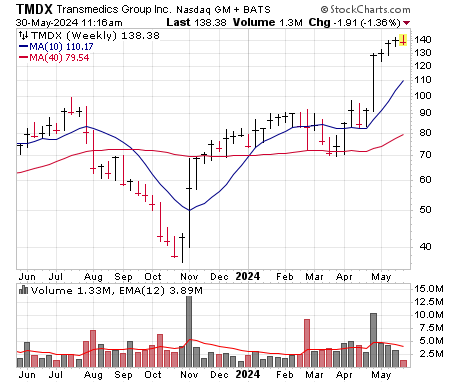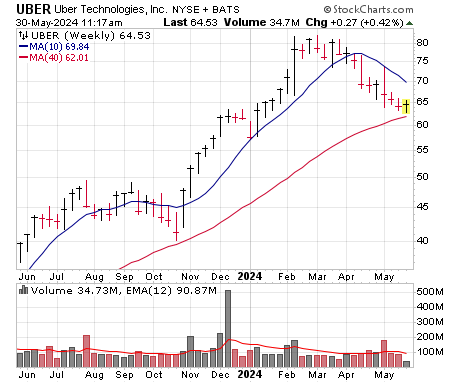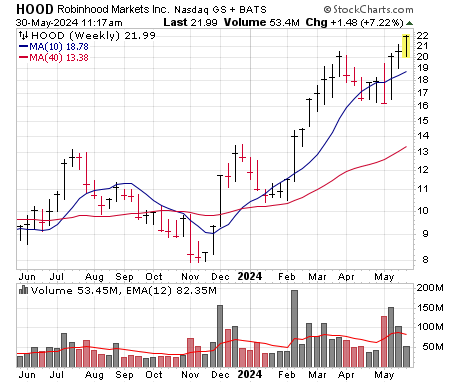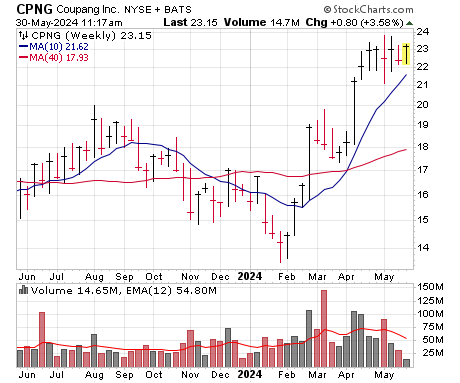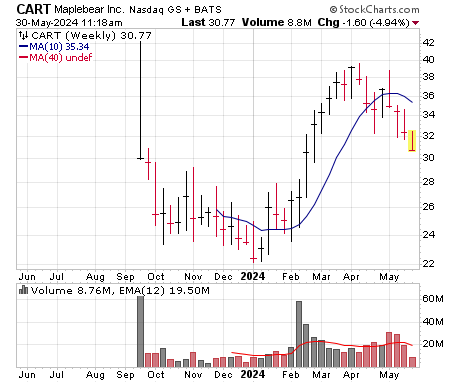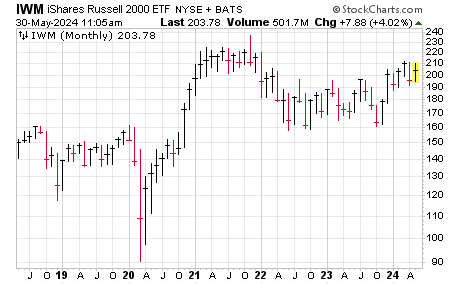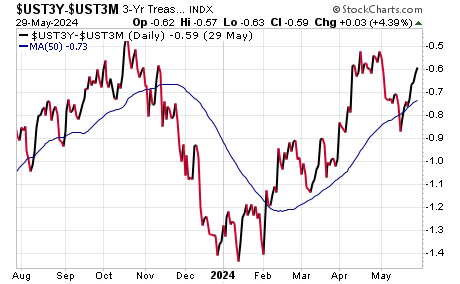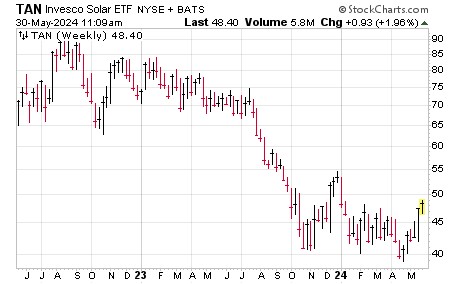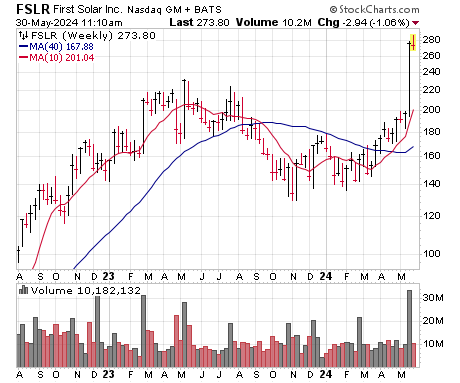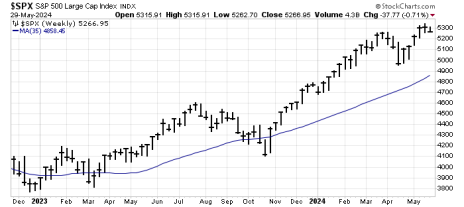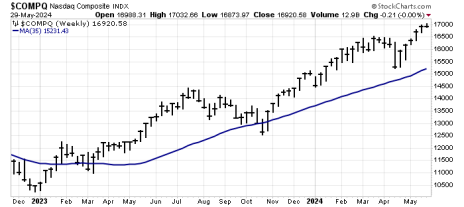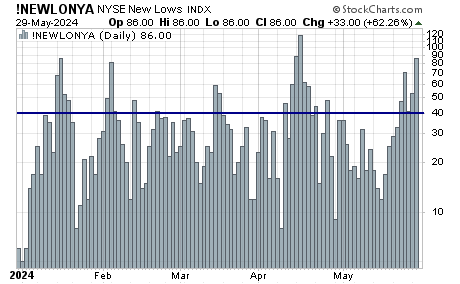Note: I have added a new video Quick Start Guide to Cabot Growth Investor, in which I take you on a guided video tour through the various features of this service, including Issues, Updates, & Alerts and where to email me with questions. Newer subscribers, in particular, may find it helpful. You can find the Quick Start Guide on the right rail of the Cabot Growth Investor main screen.
Hit or Miss
In the last issue we wrote about the market’s improvement, but explained how it was mostly due to a lack of selling pressures—which was good, yet without strong buying pressures, many areas of the market would have a difficult time motoring through resistance near their springtime highs, and similarly few stocks were running away on the upside, which is why we took is relatively slow.
And in the past two weeks the sellers have reappeared, egged on by a snapback in interest rates (which looked to be breaking down two weeks ago but are now back near their 2024 highs). Their main target has been the broad market, with many nooks and crannies giving up a chunk of their recent rally. In fact, our Cabot Tides are now on the fence as broader indexes test their 50-day lines, while our Two-Second Indicator has reflected the broad market’s reversal with a string of plus-40 readings.
To be fair, when stepping back, the broad market (whether we’re looking at small- and mid-cap indexes or things like equal-weight large-cap measures) looks a lot more trading range-y than meltdown-y. But there’s no question large swaths of the market have seen their rally stall out and run into some trouble, which isn’t something to ignore.
As for growth stocks, there are actually some encouraging signs: Our Growth Tides are still positive for one, while the Nasdaq (admittedly boosted by a shrinking number of names) hit new relative performance peaks vs. just about everything else this week (S&P 500, Dow Industrials, consumer staples, etc.).
When it comes to individual growth names, though, it’s very hit or miss—some leaders look fine, if not outstanding, with big volume coming in as their stories improve and big investors build positions. Frankly, we still see a fair number of stocks out there we’d like to own, which is usually a constructive sign. However, there are plenty of air pockets out there, too, with some winners going over the falls, and many sectors (like software today) that look like they’ve hit intermediate-term walls as the sellers swarm.
What to Do Now
With the market and growth stocks mixed, we’re going along with that evidence—holding a chunk of cash (we had 23% coming into this week), reducing or selling broken names, but also holding our resilient stocks and even doing a little buying in names that act great. In the Model Portfolio, we’ve had a slew of changes since the last issue, including some tonight:
On the sell side, we pared back on Uber (UBER), sold our stake in DraftKings (DKNG) and, on a special bulletin today, sold our position in Nutanix (NTNX), which keeled over after earnings. However, on the buy side, we started a half-sized stake in On Holding (ONON) last week, and tonight, we’re going to average up on that name (adding another half-sized position) and do the same with TransMedics (TMDX). We’re also placing CrowdStrike (CRWD) and Toast (TOST) on Hold. All told, that will leave us with around 27% in cash and a couple of names on tight leashes, as well as solid positions in a handful of real leaders. Details on all of this below.
Model Portfolio Update
For all the hoopla about new highs in the big-cap indexes, the evidence when looking at the entire picture was good but not great, which is why we were selective on the buy side after the April bottom. (That was a good move, as if we had been throwing money left and right at the market of late, many names would have failed) Now, after some wobbles last week, things have turned decidedly mixed, with our Cabot Tides and our Two-Second Indicator on the fence.
Now, with that said, there are some positives, too, as we wrote about above—our Growth Tides are still positive, with things like the iShares Momentum Fund (MTUM) and IBD 50 Index trending up. And while there have definitely been some potholes, there are also a good amount of growth stocks acting just fine.
Put it together and we’re continuing to pick our spots on the buy side while respecting any abnormal action that pops up. With that in mind, we’ve made a bunch of changes before tonight, including selling some of Uber (UBER, last week), all of DraftKings (DKNG, in two chunks both last week and this week) and all of Nutanix (NTNX, on special bulletin today). That said, we did start a position in On Holding (ONON) last week, and we’re averaging up on both that and TransMedics (TMDX) tonight. We’re also placing CrowdStrike (CRWD) on Hold.
Obviously, it’s unusual for us to have this many moves in such a short time, but that’s what the evidence tells us to do—and, most important, after all is said and done, the portfolio will have a decent cash cushion (27% or so) given our on-the-fence indicators, yet will also have stakes in many names that are acting great and should do well if the market holds itself together.
CURRENT RECOMMENDATIONS
| Stock | No. of Shares | Portfolio Weightings | Price Bought | Date Bought | Price on 5/30/24 | Profit | Rating |
| AppLovin (APP) | 3,302 | 13% | 63 | 3/1/24 | 83 | 32% | Buy |
| Cava Group (CAVA) | 2,454 | 11% | 68 | 3/8/24 | 93 | 37% | Buy |
| CrowdStrike (CRWD) | 452 | 7% | 163 | 9/1/23 | 316 | 94% | Hold |
| DraftKings (DKNG) | -- | --% | -- | 6/23/23 | -- | --% | Sold |
| Nutanix (NTNX) | -- | --% | -- | 11/3/23 | -- | --% | Sold |
| On Holding (ONON) | 2,773 | 6% | 38 | 5/24/24 | 43 | 12% | Buy Another Half |
| PulteGroup (PHM) | 1,353 | 7% | 91 | 12/1/23 | 116 | 27% | Hold |
| Pure Storage (PSTG) | 1,781 | 5% | 60 | 5/17/24 | 63 | 5% | Buy a Half |
| Toast (TOST) | 3,913 | 4% | 27 | 5/17/24 | 24 | 5% | Hold |
| TransMedix (TMDX) | 803 | 5% | 130 | 5/9/24 | 136 | 5% | Buy Another Half |
| Uber (UBER) | 1,708 | 5% | 44 | 5/19/23 | 64 | 44% | Hold |
| CASH | $771,390 | 37% |
AppLovin (APP)—AppLovin has been quiet on the news front since its terrific Q1 report, though the stock has had a few wobbles, partly due to the KKR share offering and also as glamour stocks hit some potholes. But the uptrend remains intact, and we’re optimistic there’s much more to come if management is able to make inroads in applying its Axon ad engine to other verticals; the top brass sounded very confident in the Q1 conference call on this front, though how quickly it happens (and how much it succeeds) is always an open question. As for the here and now, the firm’s numbers are impressive—not just the growth, but the actual earnings, with free cash flow in Q1 totaling $388 million, north of $1.15 per share, with the full-year tally likely to come in well above $4 per share, if not closer to $5. (We don’t buy or sell based on valuation, but at least on a free cash flow basis, APP doesn’t look expensive.) All in all, the stock looks fine, the story is solid and the numbers are excellent—hold what you own, and if you want in, we’re OK starting a position around here. BUY
Cava Group (CAVA)—CAVA remains rare merchandise, with the prospect of rapid and reliable growth coming more into focus after the Q1 results. In the quarter, revenues rose 28% and earnings of 12 cents easily surpassed expectations (up from a two-cent loss last year) while the firm opened 14 new restaurants (ended with 323 locations). Initially, the stock was hit yesterday because there were a couple of soft spots in Q1—same-store sales lifted only 2.3%, though that was mainly due to a calendar issue (would have been up 4.3% otherwise), traffic was off a smidge (but against super-tough comparisons; traffic during the past two years combined was up 17%!) and restaurant-level margins eased a bit as the firm bumped wages. However, even after taking all of that into account, the top brass actually boosted 2024 guidance by a fair amount, including for same-store sales (should grow mid- to high-single digits the rest of the year) and EBITDA, while it’s on track to open a couple more restaurants than planned (52 for the full year). The CEO says he sees signs of both people trading down from casual dining and trading up from traditional fast food, and importantly, the company is gearing up for a nationwide launch of steak on its menu after two years of testing. (It could boost the firm’s dining business, which makes up 46% of its total sales right now.) Shares looked fairly iffy yesterday morning, but buyers swooped in when the stock tagged its 25-day line and there’s been a rush of buying ever since. We’re not complacent and expect further near-term volatility, but the action is clearly supportive and the story is as good as ever. We’ll stay on Buy, though it’s probably best to aim for dips given the recent action. BUY
CrowdStrike (CRWD)—Like most stocks out there, CRWD rallied all the way back toward its old highs (and actually hit new closing highs), but it ran into resistance around there, which was normal action—but then today’s selloff in software names hit the stock very hard. The true tale will be told after earnings next Tuesday when the firm releases results; analysts are looking for revenues of $905 million and earnings of 90 cents per share, but of course many of the sub-metrics like annualized recurring revenue, free cash flow and adoption of newer offerings will be looked at closely. Stepping back, after a meaningful expansion of its offerings into new-age cybersecurity fields (creating more of a platform, rather than “only” endpoint security), as well as a big reset on the chart during the bear market, we still think the stock has an opportunity for a longer, larger run, especially with management’s bullish multi-year forecast (many years of rapid free cash flow growth is likely) and history of exceeding on its outlooks. However, while we hate to ping-pong our ratings, the fact is that today’s big-volume selling after re-testing the prior highs is definitely a yellow flag. If we had a large position, we’d probably trim, but given what we have, we’ll move back to Hold tonight and see how things go from here. HOLD
DraftKings (DKNG)—When it comes to the business of online sports betting and iGaming, DraftKings almost surely continues to do just fine, but it looks like outside factors are set to have an influence—namely, politicians in various states, which are looking to hike taxes on sports betting by big amounts. Last week saw one vote in Massachusetts (which would have raised the tax from 20% to 51%!) fail, which gave investors this week a little hope, but Illinois then passed its own tax hike (20% to 36%) with others (like New Jersey, which is a big market) possibly following suit. How this all plays out is anyone’s guess, but it’s not likely to help business, and the stock has gone over the falls—decisively cracking its April low after what’s been a lot of topping action in the 45 to 50 range since February. We had less than a full position in recent weeks, sold half of that when the selling picked up last week and then let the rest go during Tuesday’s break. We think there will be better names to own going forward. SOLD
Nutanix (NTNX)—NTNX released another steady-as-she-goes quarterly report last night: Billings were up 20%, annualized recurring revenue was up 24%, operating margin lifted 3.8 percentage points (from 10.2% to 14.0%) and free cash flow of $78 million was about triple that from last year. Nevertheless, NTNX unraveled today for a couple of reasons, the first of which is that the outlook for the current quarter was OK at best, and the top brass mentioned that some of the bigger deals that the firm thrives on are seeing longer sales cycles (i.e., clients are hesitating a bit). Probably just as important is that theme was heard elsewhere in the sector last night, causing the group to tank today (go look at Salesforce.com’s (CRM) reaction to earnings today). Of course, NTNX had been a nice winner for us and we had already taken partial profits before this, so we debated selling some/holding some—and if you want to do that, we wouldn’t argue with it. However, the near-uninterrupted run since last November combined with the action today (of both the stock and the sector) has us thinking that there will likely be big investors looking to sell or reduce for a while. Thus, it’s a disappointing ending, but we decided to take the rest of our profit off the table and look for fresher leaders going forward. We sold on a special bulletin earlier today. SOLD
On Holding (ONON)—As we wrote in the last issue, we’ve been watching On Holding for a while (and even owned it for a brief time last year), and it looks like, after numerous failures, the latest earnings-induced breakout has legs, with shares stretching to their highest levels in more than two years. One analyst recently hiked his target, saying the firm is likely to benefit from the Olympics this year, as well as some fashion-forward collaborations, boosting the apparel business. While we’re not in a big chasing mood, we think ONON is likely in the early stages of a new, sustained uptrend that could go far if the market cooperates and management makes the right moves (which they have a reliable history of doing). We’ll fill out our position here, buying another half-sized stake (5% of the portfolio), using a mental stop in the 35 area for the combined position. BUY ANOTHER HALF
PulteGroup (PHM)—Interest rates remain the story that won’t go away—after what looked like a breakdown in the middle of this month, rates kited right back to near their 2024 highs before a little slippage today. Combined with a poorly received quarterly report from peer Toll Brothers (TOL) and news of a pickup in new home inventories, that’s conspired to pull PHM lower. The stock has essentially been in a three-steps-forward, two-steps-back pattern since January—certainly not powerful, but also not disqualifying, either. A decisive drop below the April lows (at 105) would be iffy, but right here we’ll practice patience, thinking that if PHM can hold up and interest rates can settle down a bit, the major uptrend (driven by huge earnings and share buybacks) will reassert itself. HOLD
Pure Storage (PSTG)—Pure Storage has had a solid business for a while, but as its subscription business and AI-related demand kick in, things are beginning to pick up: In the quarter ending in April, revenues rose 18%, a big acceleration from recent quarters, while annualized subscription revenue (for its various storage-as-a-service offerings) totaled $1.45 billion, up 25%, and remaining performance obligations were up 27% from a year ago. Meanwhile, free cash flow was very solid (near 50 cents per share) and the top brass sees its various subscription offerings (Evergreen product lines) growing 50% for the year as a whole. Moreover, the conference call had many enticing tidbits, such as Pure being “in” the majority of Meta’s various AI environments, as well as having conversations with multiple hyperscalers (whether for AI or “regular” storage). (Indeed, a big part of the AI draw here is that firms often have to rethink their storage systems to run big AI models, which often leads them to Pure.) The stock initially gapped up on the news but was volatile given today’s growth stock selling; even so, after a long base-building effort, we’re optimistic a sustained advance is underway. We’ll sit tight tonight, though we could average up soon if PSTG and the market settle down. BUY A HALF
Toast (TOST)—Toast had a detailed Investor Day yesterday, and there was definitely some good fundamental news from it. From a big-picture point of view, the firm has “only” 13% of the U.S. restaurant market, and the only two firms larger than it are legacy players (read: older technology) that should be sources of market share gains going forward. More important, it sees its EBITDA margins for its recurring revenue streams rising from 6% last year to 13% this year and to a whopping 30% to 35% within two to three years, and rising to north of 40% beyond that. All of that sounds good—but the stock is not the company, and while shares had been pulling back normally, they cracked the 50-day line yesterday. We do like the story, there’s support right around here and the recent downmove was likely exacerbated by the market environment this week, so with a half-sized stake, we’ll hold on for now—but TOST is on a very tight leash and should essentially rally from here if all’s well. HOLD
TransMedics (TMDX)—As opposed to many stocks we own or watch, TMDX has been very much under control since its big earnings breakout a few weeks ago, with really the only wiggle it’s had coming today as many growth stocks came under the gun. But even though we don’t have a big profit, we’re going to take advantage of this mini-shakeout to fill out our position, adding another half-sized stake (5% of the account) and use a loose stop in the 110 area (give or take) for the combined position. Obviously, if the market caves in, all bets are off, but this stock came through a giant retreat (last fall) and a sideways basing area for most of the first few months of the year (hence, many weak hands should be out), and fundamentally it sports a true revolutionary offering, changing the way transplants are done in this country (and, eventually, everywhere). We’ll average up and give it room to maneuver. BUY ANOTHER HALF
Uber (UBER)—We shaved our position in UBER a bit more last week, as the stock continues to lag. To be fair, there are some rays of light out there—the stock is approaching its 200-day line (nearing 61 and rising slowly; about the same as its 40-week line in the chart below), is 21% off its high (not unusual given the prior run) and really hasn’t fallen much from the lows of its earnings day as volume dries up somewhat. Given the still-strong story in our view, we wouldn’t be surprised if the stock can start testing on the upside … but investing on maybes isn’t usually a good tactic, which is why we pared back further last week. From here, we’re content to hold our remaining shares above the 200-day line—a break below it would tell us something is likely amiss longer term, but if shares can bounce, we’ll hold on and see how things progress. For now, sit tight. HOLD
Watch List
- Core & Main (CNM 57): CNM has basically been marking time since early April, which is fine by us as earnings are due next week (June 4). The big IPO breakout and advance in recent months, along with what promises to be a steady infrastructure-related growth story, should bode well over time.
- Eli Lilly (LLY 814): LLY looks fine, but like a lot of names, isn’t able to let loose on the upside despite probing new high ground. We do think the story, while well known, has further to play out even beyond weight loss—the firm has a meeting with the FDA about its Alzheimer’s drug coming soon, which could be a big seller if approved. We’ll continue to watch.
- First Solar (FSLR 277): After a long slumber, FSLR has come to life as investor perception ratchets higher. See more later in this issue.
- Natera (NTRA 110): NTRA has been trending higher since last November without any meaningful retreat—which might mean some pent-up selling pressures could appear. Even so, the longer the stock refuses to pull back when the market gets choppy (like in April, and even more recently), the greater the odds it wants to head higher.
- Robinhood (HOOD 22): HOOD is back on our watch list as the stock shook off some whippy, weak action during the market’s dip to come storming back to new highs. See more below.
Other Stocks of Interest
Robinhood (HOOD 22)—In a market full of growth ideas involving AI chip architectures and testing equipment, data center infrastructure and the like, Robinhood offers a straightforward story: If the market entered a new bull phase last November, egged on by a couple of years of horrid performance from growth/risk-on merchandise, a soft economic landing and (eventually) an easier Fed, then Bull Market stocks are nearly a sure bet to benefit. While there’s nothing wrong at all with big asset managers (KKR looks just fine), Robinhood is a glamour name we remain very high on—the firm is definitely more geared toward individual investors and active traders, expanding its offerings here and overseas (index options, futures, 24-hour trading; all of its services now available everywhere in the U.K.) while making some big moves to attract more traders to its doors: The firm’s Gold subscription offering costs just $50 per year but gives users a higher yield (5% these days) on uninvested cash, lower margin rates and trading tools and a lucrative 3% match on all IRA deposits if they stick around for a few years (non-Gold members get a 1% match), with a potential 1% match on all deposits coming soon. (There’s even an upcoming credit card for Gold members that promises 3% cash back on all spending, which is best in class.) That helps, but the real draw is the improved market environment that’s pushing more assets into Robinhood’s coffers—net deposits through April were $16.1 billion, compared to $17.1 billion for all of 2023, with higher values driving assets under custody to $123 billion (up 59% from a year ago). Like many brokerages, higher interest rates are helping (interest income is about half of all revenue and rose 22% in Q1), though trading volumes (especially for crypto and options) make up the other half and will bob up and down with sentiment—though, again, if the bull makes progress, you have to assume business here could get much larger in the quarters to come. The stock was acting great but then wobbled and acted funky with the market in April, with a big downside reversal after Q1 results … but then saw immediate strength soon after that took HOOD back to its old highs. It’s sure to be wild and woolly, but if the market hangs in there, we could start a position in it soon.
Coupang (CPNG 23)—Coupang isn’t a household name here in the U.S., but over in Asia, it’s basically the Amazon.com of South Korea, with a very similar business model, too: The firm sells all sorts of items on its platform, has its own video streaming service and even has built up its own fulfillment and logistics operations, with many small fries that sell on Coupang also pay to use. It also has the equivalent of a Prime service (called Wow), where it recently hiked prices. A big advantage here seems to be customer service and delivery capabilities—customers can use its Rocket Delivery service that allows the shipment of millions of items (including groceries and many household items) within a day (if not the same day). Growth has been rapid for a while now (revenues in Q1 translated into $7 billion), but interestingly, management isn’t content to just grow in Korea—the firm bought Farfetch earlier this year, a global luxury retailer with four million customers, in an effort to move upscale and go global. Plus, Coupang has moved into Taiwan with its Rocket Delivery system, and while it has a modest market share so far, there’s no reason it can’t take a chunk of that market, too. Heavy investments in these new ventures and areas will probably keep the bottom line in check this year, but sales should crank ahead at a mid-20% rate with the bottom line (which is consistently in the black) picking up steam late this year and into 2025. The stock had what seemed like an endless bottoming formation from mid-2022 to February of this year, but it turned up on Q4 earnings and then the Wow price hike, and CPNG has tightened up nicely in recent weeks. International growth stocks haven’t been where it’s at in a while, but we like this story and the setup looks like a good risk/reward situation.
Maplebear (CART 31)—Maplebear is the parent company that owns Instacart, which to us looks poised to eventually become a steady-Eddie favorite among institutional investors, with a leading position in an area that has big potential. The firm is the top dog in grocery delivery, with deals with more than 1,500 different chains across the country that control 85% of the market; consumers can do all their shopping right on Instacart’s site, and in exchange, it takes a cut of sales. The industry has become increasingly popular since the pandemic, but even so online grocery shopping accounts for just 5% or so of total grocery spending, though Instacart dominates the online delivery slice of that (about 70% share) and is the second-largest online grocer overall (next to Walmart). A big advantage here besides scale is fulfillment—in Q1, 80% of delivery orders were same-day or even quicker. When you combine advertising (products that advertise on Instacart see a 15%-ish incremental uplift in sales), that alone is a solid opportunity that should lead to long-term growth, but there’s more: Instacart has partnered with Uber for restaurant delivery, with customers able to order via the Instacart app but have the food delivered by Uber Eats. And then there’s a very recent deal last week with Home Depot, offering same-day delivery nationwide from more than 2,000 of Depot’s locations (including for items up to 60 pounds like grills, ladders and large boxes); long term, there’s no limit to the things many would prefer to have just delivered to their door. There is competition, of course, but management here has proven deft at making the right moves, leading to consistent growth: In Q1, total order volume was $8.3 billion, up 11%, as the number of orders lifted 9%, revenues gained 8% and EBITDA rose 17% (with big 24% EBITDA margins). After a multi-month bottom, shares had an excellent run back to their prior IPO highs, but CART pulled back with the market and has taken on some water since earnings. Right now, then, it still has some repair work to do, but CART is a well-traded IPO with growing sponsorship that should have a sustained run once this base-building effort is completed. We don’t advise entering here, but we’ll be keeping a distant eye on CART as the story has long-term dependable growth written all over it.
Still Watching Small Caps (and Rate Cut Expectations)
Late last year when the market was powering ahead, we took a swing at a leveraged long fund that invested in small caps, with three reasons behind the move. The first was the setup: Yes, the entire growth and risk-on side of the market had been out of favor since early 2021, but for small caps, the dead period was even more pronounced, with the Russell 2000 (IWM) making no net progress from the summer of 2018 until the fall low of 2023—more than five years!
The second reason, of course, was that the dead period was ending, with the November-December action representing a major turn up in the market for growth titles—and that big-picture box remains checked, with the action of the past few months (along with plenty of other longer-term evidence) suggesting we’re still relatively early on in a new bull phase.
But the third reason we entered was the path of interest rates—and that’s clearly where perceptions have changed. IWM, in fact, outperformed the big-cap indexes during the first couple of months of the rally, at least in part because of expectations the Fed would quickly turn from foe to friend and Treasury rates sank. But that’s hit a speed bump this year.
Shown below is a chart that takes the three-month Treasury bill yield (which mimics the Fed Funds rate) and subtracts it from the three-year Treasury yield. You can see that, into January, investors were pricing in an increasing amount of cuts (falling prices in this chart), but nearly all of those expectations were taken back by mid-April, which is a big reason why IWM was actually down around 4% on the year at that time. (We got knocked out of our half-sized stake by early February.)
But we’re still watching small caps, and we’re writing about them today because the pendulum of interest rate expectations might be ready to swing lower—for good this time, as the Fed actually does go ahead with rate cuts sometime in the months ahead. Fundamentally, many of the companies in the index are unprofitable and/or rely on borrowing (financials are the second-largest sector weighting in the index), so easier money should instantly hike earnings outlooks. If the chart above (three-year yield minus three-month yield) dives below its 50-day moving average, that could be a clue, as would IWM itself moving out to new highs (decisively above 210) or so.
Bottom line: At some point, small-cap names are likely to have a huge run given their underperformance in recent years and the fact we’re in a new bull phase. Right now, we’re again intrigued by the setup, and while we’re not anxious to jump the gun, we could take another swing at the ProShares Ultra Russell 2000 Fund (UWM), which moves double the Russell 2000 Index (up and down), if the pieces fall into place.
Reality vs. Investor Perception: It’s the Latter that Counts
First Solar (FSLR)
In the real world, there’s little doubt that the alternative energy movement is plowing ahead, with the usual fits and starts, with the market share of electric (and hybrid) vehicles heading higher along with wind and solar power. Despite that, though, investor perception of the broad alternative energy sector has headed south during the past year or two, and that’s doubly true when looking at solar stocks—the Invesco Solar ETF (TAN) has lagged the market badly during the past couple of years and actually tagged new lows last month!
For solar names, there was a simple reason for the split between reality and perception: competition, namely from China, where output (and exports) of panels and modules went up, driving prices down. Now, though, Uncle Sam is stepping in, hiking various tariffs (though letting some others expire) while China has said it’s aiming to limit overproduction. Combined with the still-huge incentives from the green energy bill of 2022, and some in the group have come to life.
That leads us to First Solar (FSLR), which is the hands-down liquid leader in the group for a few reasons. First, its panels use cadmium telluride instead of the standard silicon, leading to higher efficiencies. That, along with the green energy bill and various capacity expansions, has been a perfect combination, allowing the firm to ink massive amounts of orders for years into the future—its backlog of nearly 73 gigawatts extends out in some cases to 2030, so weak pricing hasn’t had an impact here. Hence, sales and earnings have been huge ($7.74 per share in 2023, an expected $13.56 this year) and are expected to continue to mushroom going forward.
Now, to be fair, a lot of the profits right now are via the government—about half of the firm’s gross margin dollars in 2024, for instance, is expected to be green energy tax credits, which does raise political (election) risk. But with a massive and growing backlog at decent sales prices, and now with the tariff news, FSLR has emerged from its very long slumber: As of a month ago, the stock had made no progress since December 2022, but last week saw overwhelming accumulation as investor perception shifted. We’re not chasing it here, but this looks like an early-stage breakout for both FSLR and the group. WATCH
Cabot Market Timing Indicators
Cabot Trend Lines – Bullish
There are again many factors out there telling us that the bulls and bears are fighting it out, but our Cabot Trend Lines remind us of the most important fact: That it’s still a bull market and we should see higher prices down the road. Indeed, right now, the indicator remains in good shape, with the S&P 500 (by 7%) and Nasdaq (by 9%) standing clearly above their 35-week lines, telling us the long-term trend is firmly up.
Cabot Tides – On the Fence
The good-not-great rally of late has hit a snag, with many indexes running in selling near their springtime peaks. That has our Cabot Tides on the fence—while the big-cap S&P 500 and Nasdaq are still positive, the broader indexes we track (including the S&P 600 Small Cap, shown here) are near or a bit below their 50-day lines. We would say that the Growth Tides are more resilient (still positive), but for the market as a whole, the intermediate-term trend is on the fence.
Two-Second Indicator – Neutral
Our Two-Second Indicator was looking terrific, but like the broad market, it’s changed character once again, likely driven in part by the back-up in interest rates—today was the sixth straight day of plus-40 new lows, which follows 18 straight tame readings, which itself followed a string of elevated readings. Clearly, it’s a ping-pong situation, with the sellers gaining the upper hand right now.
The next Cabot Growth Investor issue will be published on June 13, 2024.
Copyright © 2024. All rights reserved. Copying or electronic transmission of this information without permission is a violation of copyright law. For the protection of our subscribers, copyright violations will result in immediate termination of all subscriptions without refund. Disclosures: Cabot Wealth Network exists to serve you, our readers. We derive 100% of our revenue, or close to it, from selling subscriptions to our publications. Neither Cabot Wealth Network nor our employees are compensated in any way by the companies whose stocks we recommend or providers of associated financial services. Employees of Cabot Wealth Network may own some of the stocks recommended by our advisory services. Disclaimer: Sources of information are believed to be reliable but they are not guaranteed to be complete or error-free. Recommendations, opinions or suggestions are given with the understanding that subscribers acting on information assume all risks involved. Buy/Sell Recommendations: are made in regular issues, updates, or alerts by email and on the private subscriber website. Subscribers agree to adhere to all terms and conditions which can be found on CabotWealth.com and are subject to change. Violations will result in termination of all subscriptions without refund in addition to any civil and criminal penalties available under the law.
